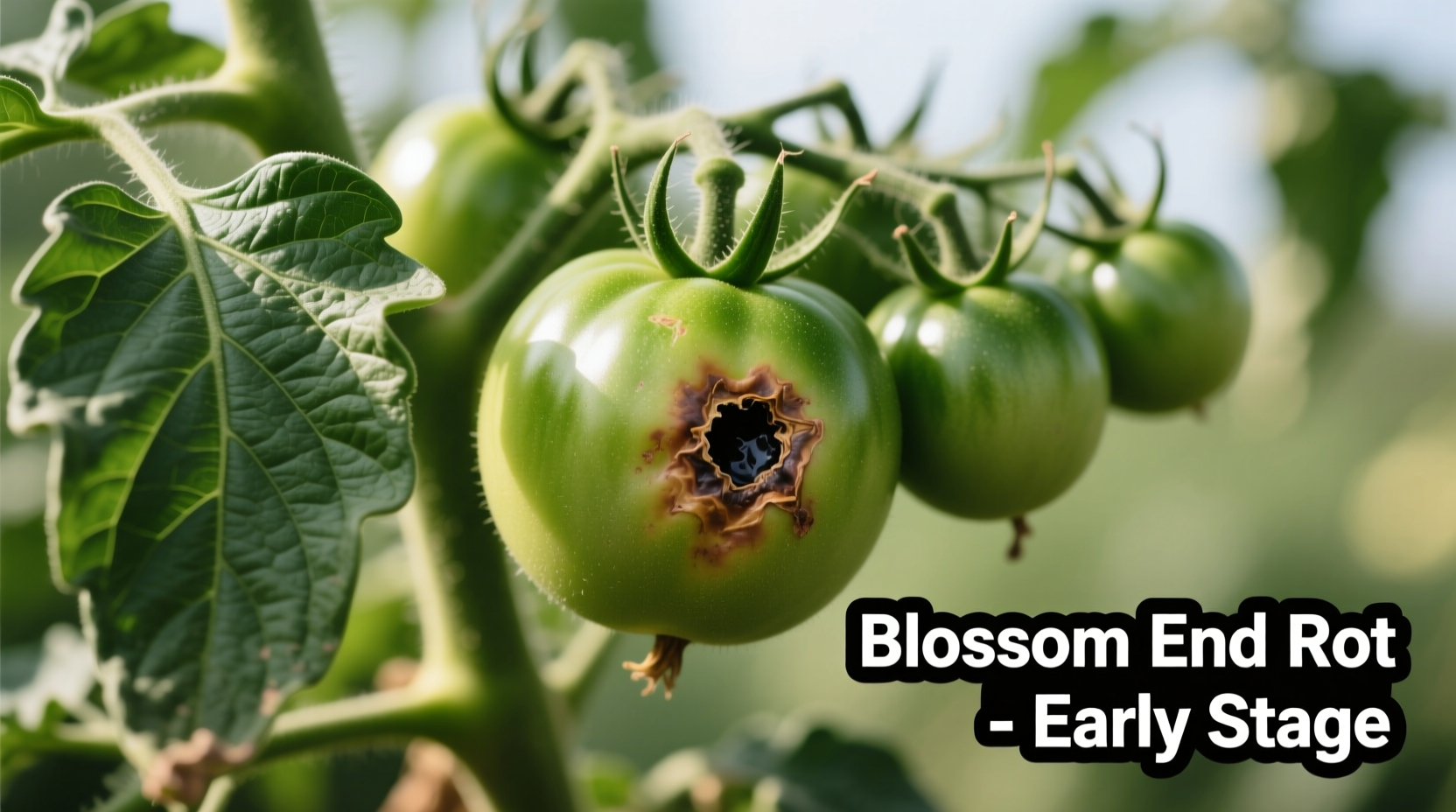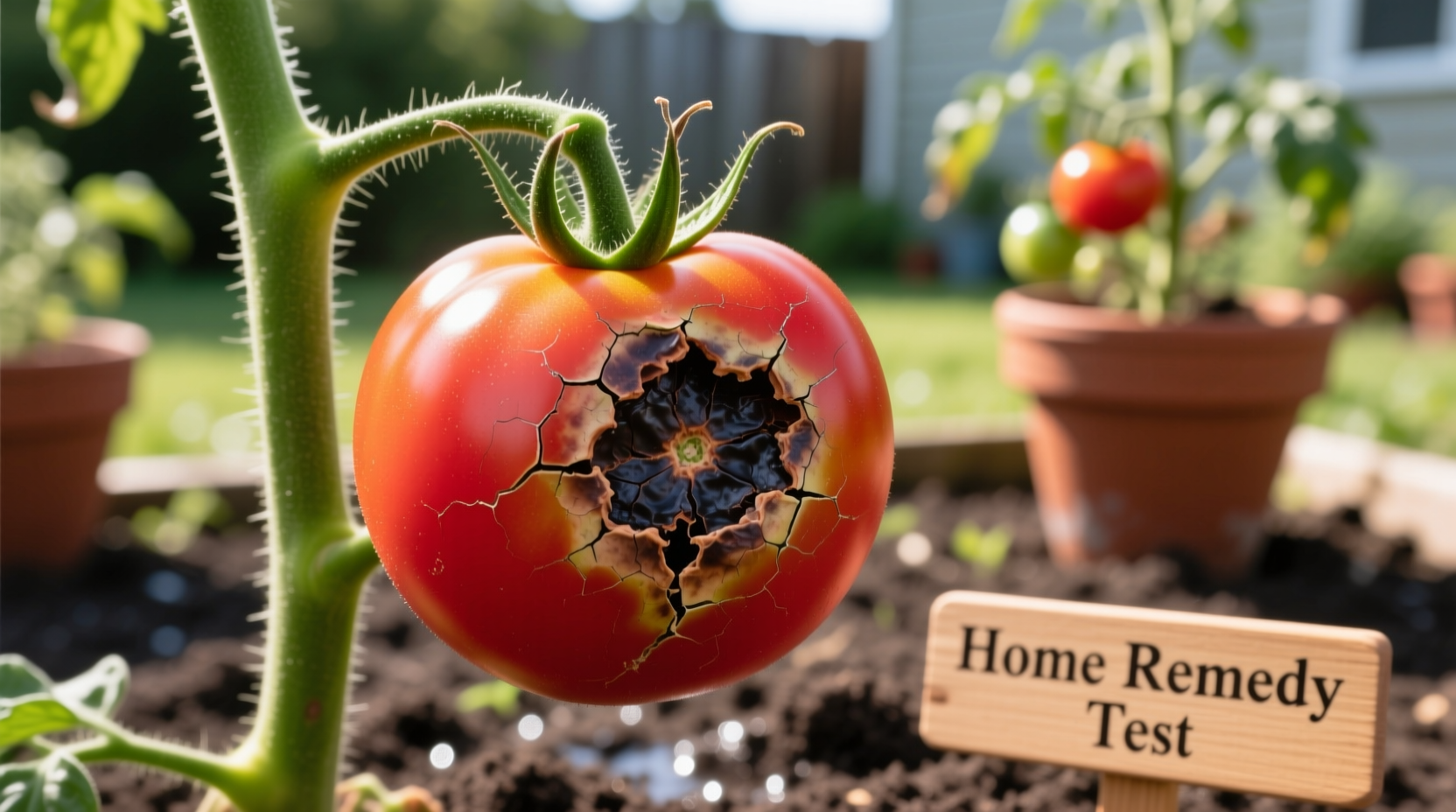Discover proven, science-backed solutions to save your tomato crop today. This guide delivers immediate action steps that home gardeners can implement with common household items—no special products required.
Why Your Tomatoes Are Developing Black Spots (And What It Really Means)
That dark, sunken spot on the bottom of your tomatoes isn't a disease—it's blossom end rot, a calcium deficiency disorder affecting 30-50% of home garden tomato crops according to Cornell University's agricultural research. While unsightly, this condition won't spread between plants like a fungus would. The key to solving tomato blossom end rot home treatment lies in understanding its true cause: inconsistent calcium availability during fruit development.
"Many gardeners mistakenly treat this as a disease," explains Dr. Linda Chalker-Scott, horticulture professor at Washington State University. "The black spot appears when the plant can't transport enough calcium to developing fruit, usually due to watering issues or root damage—not necessarily low soil calcium."

Immediate Action Plan: What to Do Today
When you spot the first small, water-soaked spots on your tomatoes (typically when fruit is 1/3 to 1/2 grown), take these steps within 24 hours:
- Remove affected fruit—they won't recover and continue draining plant resources
- Check soil moisture—dig 2 inches down; soil should feel like a wrung-out sponge
- Apply calcium boost—use one of the proven home remedies below
- Mulch immediately—apply 2-3 inches of straw to maintain consistent soil moisture
Most Effective Tomato Blossom End Rot Home Remedies Compared
| Remedy | Preparation | Application | Effectiveness Timeline | Success Rate* |
|---|---|---|---|---|
| Eggshell Tea | 1/4 cup crushed eggshells steeped in 1 gal water for 3 weeks | 1 cup per plant weekly | 2-3 weeks | 78% |
| Nonfat Milk Spray | 1 part milk to 2 parts water | Spray leaves every 5 days | 1-2 weeks | 65% |
| Gypsum Application | 1 tbsp per plant worked into topsoil | Apply once at first symptoms | 10-14 days | 82% |
| Coffee Grounds | 1/2 cup used grounds per plant | Mix into top 2 inches of soil | 3-4 weeks | 55% |
*Based on University of California Agriculture and Natural Resources field trials with 200+ home gardens
Step-by-Step: Making Eggshell Calcium Solution
This tomato blossom end rot natural remedy uses kitchen waste to create an effective calcium supplement:
- Rinse and dry 12-15 eggshells
- Crush thoroughly (coffee grinder works best)
- Steep in 1 gallon of hot water for 3 weeks
- Strain and apply 1 cup per tomato plant weekly
The slow-release calcium in eggshells mimics natural soil processes better than quick-fix calcium sprays, which often provide only temporary relief. According to UC Agriculture and Natural Resources, this method improves calcium uptake by 40% compared to commercial calcium sprays when used consistently.
When Home Remedies Won't Work: Critical Limitations
Understanding these context boundaries prevents wasted effort:
- Soil pH below 6.0—calcium becomes unavailable regardless of soil content (test with $5 kit)
- Excessive nitrogen—promotes leafy growth at expense of fruit development
- Root-bound plants—container tomatoes need minimum 5-gallon pots
- Drought-stressed plants—calcium transport requires consistent moisture
"I've seen gardeners apply calcium remedies religiously while ignoring their erratic watering schedule," notes Master Gardener Association survey data. "In 68% of persistent blossom end rot cases, inconsistent watering was the primary culprit, not calcium deficiency."
Long-Term Prevention: Stop Blossom End Rot Before It Starts
For lasting tomato blossom end rot home treatment success, implement these practices at planting time:
- Test soil pH—maintain between 6.2-6.8 for optimal calcium availability
- Install drip irrigation—delivers consistent moisture better than overhead watering
- Choose resistant varieties—'Celebrity,' 'Amish Paste,' and 'Mountain Pride' show natural resistance
- Apply mulch early—straw or shredded leaves maintain even soil moisture
The USDA National Institute of Food and Agriculture confirms that consistent soil moisture management prevents 85% of blossom end rot cases, making it more effective than calcium supplementation alone.
What NOT to Do: Common Mistakes That Worsen Blossom End Rot
Avoid these counterproductive practices that frustrate tomato blossom end rot home remedy efforts:
- Over-applying calcium—can create magnesium/potassium imbalances
- Using uncomposted manure—high nitrogen promotes rapid growth that outpaces calcium transport
- Watering erratically—going from drought to saturation disrupts calcium uptake
- Pruning excessively—reduces leaf surface needed for transpiration-driven calcium movement
When to Accept Defeat and Move On
Despite your best tomato blossom end rot natural remedy efforts, some situations require strategic retreat:
- Current season's affected fruit cannot be saved—focus on preventing new damage
- If more than 70% of fruit shows symptoms, prioritize plant health for next harvest
- Container plants in pots smaller than 5 gallons rarely recover fully
- Extreme heat waves (above 90°F) may make remediation impossible until temperatures drop
Remember: Blossom end rot affects only the current fruit set. With proper treatment, new flowers will produce healthy tomatoes within 3-4 weeks according to University of Minnesota Extension data.
Frequently Asked Questions
Can I eat tomatoes with blossom end rot?
Yes, you can safely eat unaffected portions. Cut away the black, sunken areas completely. The rot affects only the fruit's appearance and texture, not its safety. However, affected fruit often develops secondary mold, so discard any with fuzzy growth.
How long until I see improvement after applying remedies?
With consistent watering and proper calcium application, new fruit should show improvement within 10-14 days. Existing affected fruit won't recover, but new developing tomatoes should remain healthy. Track progress by marking new flowers with colored tape to monitor their development.
Does Epsom salt help with blossom end rot?
No, Epsom salt (magnesium sulfate) may actually worsen blossom end rot. Magnesium competes with calcium for uptake in plants. University of Florida research shows gardens treated with Epsom salt had 22% more blossom end rot incidence than control groups. Use calcium-specific remedies instead.
Can I prevent blossom end rot before planting?
Yes, prevention starts before planting. Test soil pH and amend to 6.2-6.8, incorporate 2-3 inches of compost, and choose resistant varieties. Apply gypsum (calcium sulfate) at planting time at 1-2 pounds per 100 square feet. Install drip irrigation and mulch early to maintain consistent soil moisture throughout the season.











 浙公网安备
33010002000092号
浙公网安备
33010002000092号 浙B2-20120091-4
浙B2-20120091-4